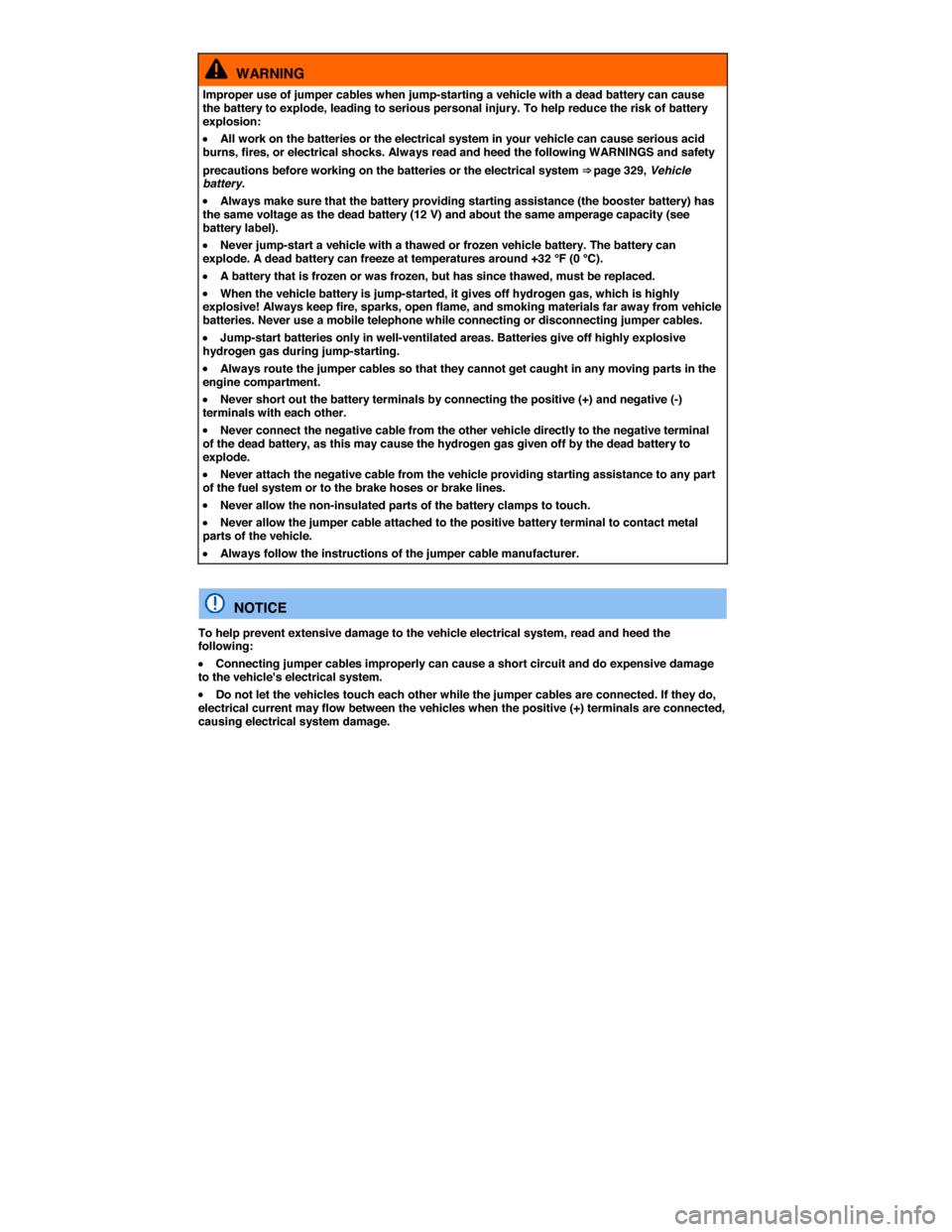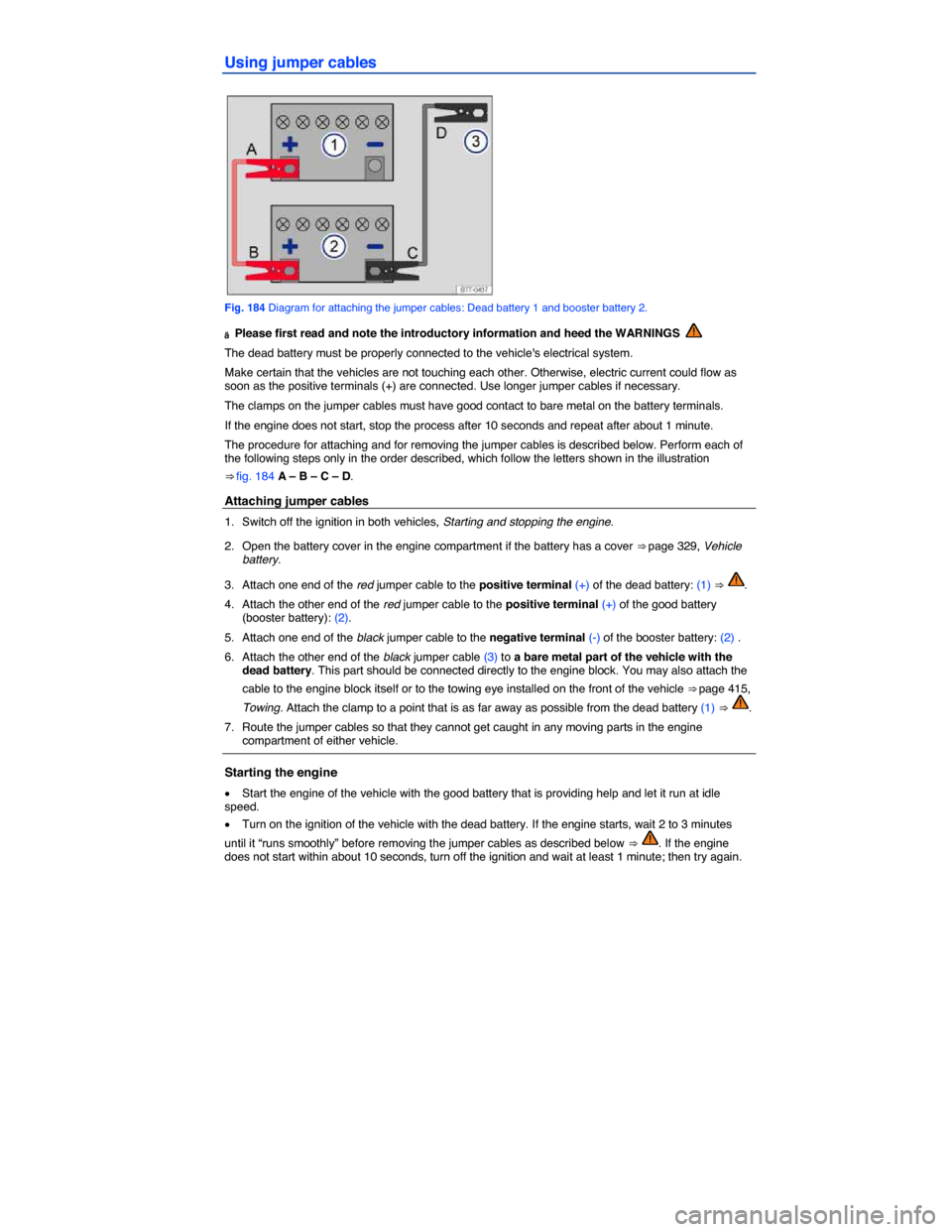2014 VOLKSWAGEN JETTA GLI jump start terminals
[x] Cancel search: jump start terminalsPage 346 of 357

WARNING
Improper use of jumper cables when jump-starting a vehicle with a dead battery can cause the battery to explode, leading to serious personal injury. To help reduce the risk of battery explosion:
�x All work on the batteries or the electrical system in your vehicle can cause serious acid burns, fires, or electrical shocks. Always read and heed the following WARNINGS and safety
precautions before working on the batteries or the electrical system ⇒ page 329, Vehicle battery.
�x Always make sure that the battery providing starting assistance (the booster battery) has the same voltage as the dead battery (12 V) and about the same amperage capacity (see battery label).
�x Never jump-start a vehicle with a thawed or frozen vehicle battery. The battery can explode. A dead battery can freeze at temperatures around +32 °F (0 °C).
�x A battery that is frozen or was frozen, but has since thawed, must be replaced.
�x When the vehicle battery is jump-started, it gives off hydrogen gas, which is highly explosive! Always keep fire, sparks, open flame, and smoking materials far away from vehicle batteries. Never use a mobile telephone while connecting or disconnecting jumper cables.
�x Jump-start batteries only in well-ventilated areas. Batteries give off highly explosive hydrogen gas during jump-starting.
�x Always route the jumper cables so that they cannot get caught in any moving parts in the engine compartment.
�x Never short out the battery terminals by connecting the positive (+) and negative (-) terminals with each other.
�x Never connect the negative cable from the other vehicle directly to the negative terminal of the dead battery, as this may cause the hydrogen gas given off by the dead battery to explode.
�x Never attach the negative cable from the vehicle providing starting assistance to any part of the fuel system or to the brake hoses or brake lines.
�x Never allow the non-insulated parts of the battery clamps to touch.
�x Never allow the jumper cable attached to the positive battery terminal to contact metal parts of the vehicle.
�x Always follow the instructions of the jumper cable manufacturer.
NOTICE
To help prevent extensive damage to the vehicle electrical system, read and heed the following:
�x Connecting jumper cables improperly can cause a short circuit and do expensive damage to the vehicle's electrical system.
�x Do not let the vehicles touch each other while the jumper cables are connected. If they do, electrical current may flow between the vehicles when the positive (+) terminals are connected, causing electrical system damage.
Page 347 of 357

Using jumper cables
Fig. 184 Diagram for attaching the jumper cables: Dead battery 1 and booster battery 2.
ä Please first read and note the introductory information and heed the WARNINGS
The dead battery must be properly connected to the vehicle's electrical system.
Make certain that the vehicles are not touching each other. Otherwise, electric current could flow as soon as the positive terminals (+) are connected. Use longer jumper cables if necessary.
The clamps on the jumper cables must have good contact to bare metal on the battery terminals.
If the engine does not start, stop the process after 10 seconds and repeat after about 1 minute.
The procedure for attaching and for removing the jumper cables is described below. Perform each of the following steps only in the order described, which follow the letters shown in the illustration
⇒ fig. 184 A – B – C – D.
Attaching jumper cables
1. Switch off the ignition in both vehicles, Starting and stopping the engine.
2. Open the battery cover in the engine compartment if the battery has a cover ⇒ page 329, Vehicle battery.
3. Attach one end of the red jumper cable to the positive terminal (+) of the dead battery: (1) ⇒ .
4. Attach the other end of the red jumper cable to the positive terminal (+) of the good battery (booster battery): (2).
5. Attach one end of the black jumper cable to the negative terminal (-) of the booster battery: (2) .
6. Attach the other end of the black jumper cable (3) to a bare metal part of the vehicle with the dead battery. This part should be connected directly to the engine block. You may also attach the
cable to the engine block itself or to the towing eye installed on the front of the vehicle ⇒ page 415,
Towing. Attach the clamp to a point that is as far away as possible from the dead battery (1) ⇒ .
7. Route the jumper cables so that they cannot get caught in any moving parts in the engine compartment of either vehicle.
Starting the engine
�x Start the engine of the vehicle with the good battery that is providing help and let it run at idle speed.
�x Turn on the ignition of the vehicle with the dead battery. If the engine starts, wait 2 to 3 minutes
until it “runs smoothly” before removing the jumper cables as described below ⇒ . If the engine does not start within about 10 seconds, turn off the ignition and wait at least 1 minute; then try again.
Page 348 of 357

Before removing the jumper cables
�x Switch off the headlights (if they are on).
�x In the vehicle with the dead battery, switch on the heater fan and the rear window defroster. This helps to minimize voltage spikes when the cables are disconnected.
Removing jumper cables
With the engine running, remove the jumper cables in reverse order to the way they were connected.
1. Disconnect the black (-) cable from the vehicle with the dead battery.
2. Disconnect the black (-) cable from the other vehicle (vehicle with the good battery).
3. Disconnect the red (+) cable from the other vehicle (vehicle with the good battery).
4. Disconnect the red (+) cable from the vehicle with the dead battery.
5. Close the battery cover.
6. If necessary, unscrew the towing eye on the front of the vehicle, Installing the front towing eye.
WARNING
Improper use of jumper cables when jump-starting a vehicle with a dead battery can cause the battery to explode, leading to serious personal injury. To help reduce the risk of battery explosion:
�x All work on the batteries or the electrical system in your vehicle can cause serious acid burns, fires, or electrical shocks. Always read and heed the following WARNINGS and safety precautions before working on the batteries or the electrical system, Vehicle battery.
�x Always wear proper eye protection. Never lean over the vehicle battery.
�x Attach the jumper cables in the correct order: first the positive cable, then the negative cable.
�x Never connect the negative cable from the vehicle providing starting assistance to parts of the fuel system or to the brake hoses or brake lines.
�x Never allow the non-insulated parts of the battery clamps to touch.
�x Never allow the jumper cable attached to the positive battery terminal to contact metal parts of the vehicle.
�x Check the battery acid level indicator window on the vehicle battery. Use a flashlight, never a match, cigarette lighter, or other open flame. If you cannot see the color of the window clearly, or if it is light yellow or colorless, do not jump-start the vehicle. Get expert assistance.
�x Avoid electrostatic discharge in the vicinity of the vehicle battery. Sparks may cause the hydrogen gas escaping from the vehicle battery to ignite.
�x Never jump-start a vehicle with a battery that is damaged or frozen or that was frozen and has thawed. The battery can explode. Replace the battery instead.
�x Always follow the instructions of the jumper cable manufacturer.
�x Always make sure that the battery providing starting assistance has the same voltage as the dead battery (12 V) and about the same capacity (see battery label).
�x Batteries give off explosive hydrogen gas. Always keep fire, sparks, open flame and smoking materials away from batteries.
�x Never connect the negative cable from the other vehicle directly to the negative terminal of the dead battery. The hydrogen gas from the battery is explosive.
�x Never short out the battery terminals by connecting the positive (+) and negative (-) terminals with each other.